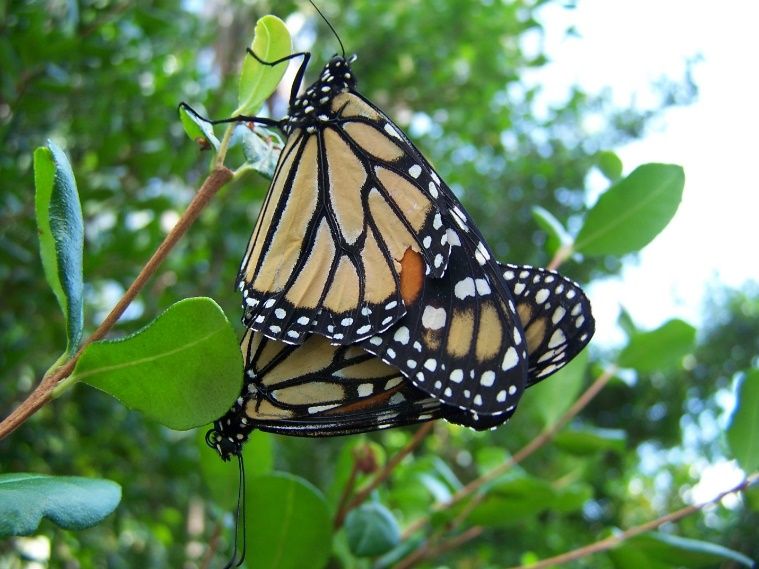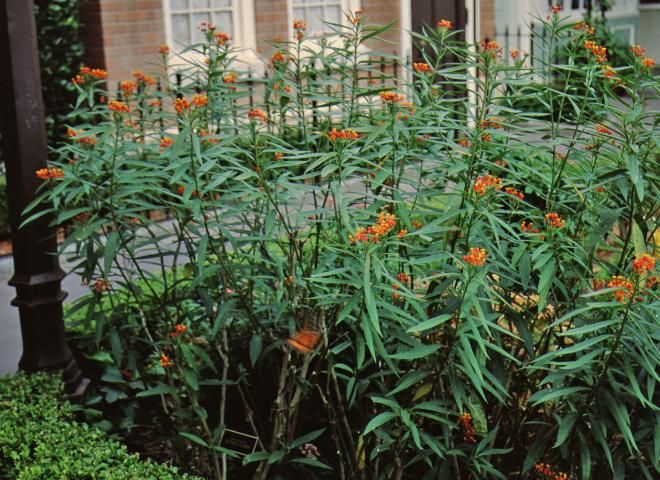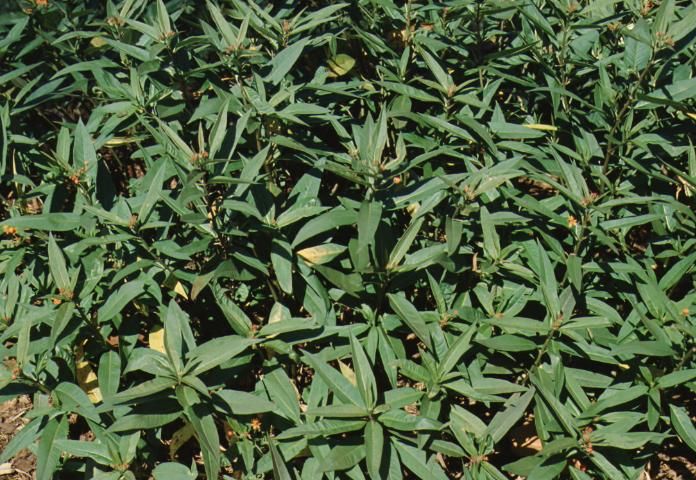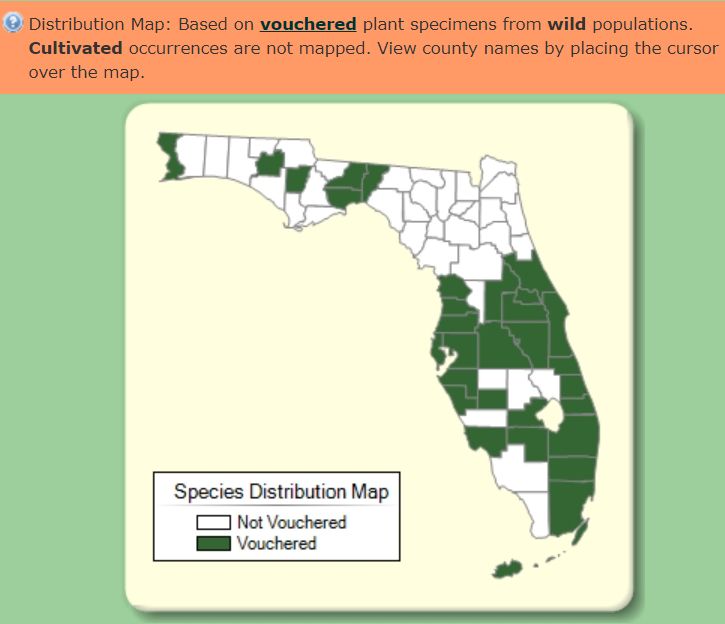Asclepias curassavica Tropical Milkweed, Silkweed
Introduction
Tropical milkweed is native to Mexico and is a host and nectar plant for the Monarch Butterfly (Danaus plexippus), a species currently listed as a candidate under the Endangered Species Act with annual review (US Fish & Wildlife Service https://www.fws.gov/savethemonarch/ssa.html).

Credit: Tina McIntyre, UF/IFAS
This plant stays green until cold weather brings frost throughout the Southern United States. If frost is delayed or does not come, the plant leaves and nectar allow the Monarch Butterflies to keep breeding through the fall and winter, instead of migrating south . Because of this, the species can stay longer than they would historically. Continual breeding can lead to more instances of infection caused by the lethal protozoan parasite, Ophryocystis elektroscirrha (OE). Persistent plant flowering into the colder months in Florida can also lead to preventing the Monarchs from migrating South, which can increase the risk of their exposure to freezing temperatures, resulting in the potential death of adult butterflies or immature stage (https://flawildflowers.org/non-native-milkweeds-killing-monarchs/). In light of this, it is recommended that the plants are cut to the ground by December in Florida, specifically USDA Zones 8-11.

Credit: Tina McIntyre, UF/IFAS
Tropical milkweed can be grown as an annual flower or a perennial. The plants grow two- to four-feet-tall and flowers from spring until fall. The flower colors are red and orange borne in clusters at the top of the plant. Butterflies can usually be seen flying around the plant and visiting the flowers.

Credit: Edward F. Gilman, UF/IFAS

Credit: Edward F. Gilman, UF/IFAS

Credit: Tina McIntyre, UF/IFAS
General Information
Scientific name: Asclepias curassavica
Pronunciation: as-KLEE-pee-us kur-uh-SAV-ick-uh
Common name(s): tropical milkweed, milkweed, silkweed, bloodflower, butterfly weed
Family: Apocynaceae
Plant type: herbaceous perennial; possibly as an annual in North Florida with freezes
USDA hardiness zones: 4 through 8b as an annual, perennial 9a through 11b (Figure 6).
Planting month for zone 7: Jun; Jul
Planting month for zone 8: May; Jun; Jul; Aug. Cut to the ground by December to ensure butterfly migration.
Planting month for zone 9: Mar; Apr; May; Jun; Jul; Aug. Cut to the ground by December to ensure butterfly migration.
Planting month for zone 10 and 11: Feb; Mar; Apr; May; Jun; Jul; Aug; Sep; Cut to the ground by December to ensure butterfly migration.
Origin: native to Central America, Mexico, and South America
Invasive Potential: Caution in South and Central Florida; manage to prevent escape. North Florida may be recommended by UF/IFAS faculty. Reassessment currently in process for North and Central Florida https://assessment.ifas.ufl.edu/assessments/asclepias-curassavica/
Uses: cut flowers; attracts butterflies; mass planting
Availability: widely available

Credit: undefined

Credit: undefined
Description
Height: 2 to 4 feet
Spread: 1 to 2 feet
Plant habit: round; upright
Plant density: moderate
Growth rate: fast
Texture: medium
Foliage
Leaf arrangement: alternate
Leaf type: simple
Leaf margin: entire
Leaf shape: oblong
Leaf venation: parallel
Leaf type and persistence: deciduous
Leaf blade length: 4 to 8 inches
Leaf color: green
Fall color: not applicable
Fall characteristic: not applicable
Flower
Flower color: red; yellow
Flower characteristic: summer flowering; spring flowering
Fruit
Fruit shape: oblong capsule with pointed end facing upward
Fruit length:3-4 inches
Fruit cover: unknown
Fruit color: green to tan or brown
Fruit characteristic: inconspicuous and not showy
Trunk and Branches
Trunk/bark/branches: not applicable
Current year stem/twig color: green
Current year stem/twig thickness: 0.25 - 0.5 inches
Culture
Light requirement: plant prefers full sun, but can also persist in part shade
Soil tolerances: acidic; slightly alkaline; sand; loam; clay
Drought tolerance: high
Soil salt tolerances: poor
Plant spacing: 18 to 24 inches
Other
Roots: not applicable
Winter interest: no special winter interest. Be sure to cut this plant back to the ground in December to encourage butterfly migration.
Pest resistance: high
Use and Management
As plants age and become somewhat woody near the base of the plant, cut them back to stimulate new growth near the bottom. This will help them look good for many years and better protect the Monarch butterfly we hope to support.
The best sites have exposure to sun or partial shade. Tropical milkweed is slow to start growth in the spring. Mark its location in hardiness zones 7 and parts of 8 before the plant disappears in the winter to prevent damage to easily injured dormant crowns. A deep root (taproot) reportedly makes transplanting difficult. Once established do not disturb tropical milkweed unnecessarily. No fertilization is needed for this plant to thrive.
Design Considerations
The thin stems and widely spaced leaves of the butterfly weed give a slightly weedy appearance (hence the name), so most gardeners mix them with shorter plants where the bright red and yellow flowers can be easily seen above the ground cover. The leaves can be stripped by caterpillars and the plant often looks stick-like at certain times of the year so using ground cover also helps hide the bare stems until they can be cut back. Pair with plants with large foliage and mounding or loose spreading forms to help the butterfly weed poke through the plants. White or purple flowers are complementary colors to yellow and red, which will contrast nicely.
Pests and Diseases
Aphid infestations are common on mature plants, however, do not commonly cause plant death.
Monarch caterpillars will use this are their food source, as it is a host plant for their species. They commonly eat all the leaves off maturing plants, but this will not kill the plant.
Leaf spot diseases are seen but not serious.
Rusts cause the formation of reddishcolored spots.
Cucumber mosaic virus causes leaf mottling, but no chemical control is available.


